Paediatric Allergy COPY Flashcards
what is the pathophysiology of allergy?
The underlying mechanism involves immunoglobulin E antibodies (IgE), part of the body’s immune system, binding to an allergen and then to a receptor on mast cells or basophils where it triggers the release of inflammatory chemicals such as histamine
IgE bind to mast cells and that’s where out develop sensitisation to an allergen

what is mast cell degranulation?
- Rapid release and onset of symptoms: Histamine , Tryptase, Hydrolase
- Later release with subsequent effects (Biphasic reaction):
Secreted inflammatory mediators – Prostaglandins, Leukotrienes, PAF, Cytokines
what are the effects of histamine?
- Bronchial smooth muscle contraction
- Vasodilation
- Separation of endothelial cells (responsible for hives) (also oedema)
- Pain and itching
Is it allergy? - what features point towards allergy?
Do I think it is IgE mediated allergy
Want to see immediate development of the reactions within minutes and certainly within an hour
Longer it takes for a reaction to manifest itself, less likely it will be IgE meidated

what are Common Food Allergens (>90%)?

How severe was the reaction? :
what would oyu see in mild/moderate reacitons and what would you see in severe reacitons?
Cardiovascular or respiratory involvement is real danger signs
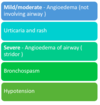
what is Supporting evidence that the reaction is an allergy?
preivous reactions
atopy
family history
response to treatment
co-exisitng asthma
what are the 3 main investigaitons?
- Skin Prick Testing
- Specific IgE (blood test)
- Oral Food Challenge
what is Skin-prick testing?
- Easy to perform
- Non-invasive
- Immediate results (within 20 minutes)
- Cheap
- Negative SPT is an excellent predictor for a negative IgE mediated food reaction in patients with anaphylaxis (>95%)
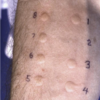
what are the pitfalls of skin prick tesitng?
- Must stop antihistamines 48hrs prior
- Broken skin
- Theoretical risk of reactions
- Dermatographism
- Over-interpretation of positive results
- Avoid random tests
what are the features of Specific IGE?
- No-need to stop antihistamines
- No risk of reactions
- Expensive and invasive
- Delay in obtaining results
- Less sensitive and specific than SPT
- Highly unreliable results in eczema
what are the +ve and -vs of SPT and specific IgE?

how should Oral Food Challenge be done?
- Day case procedure
- Gold standard
- What actually happens upon contact or ingestion
what is needed to make a diagnosis?
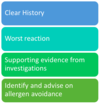
how common is Urticaria and Angioedema?
- Lifetime Prevalence of 8.8%
- Chronic (>6 weeks) in 30-45%
- Urticaria alone 50%
- Urticaria + Angioedema 40% (Sabre et Al 85%)
- Angioedema alone 10%
- Up to 20% of those referred to hospital remain symptomatic after 10 years
how do you invesitgate urticaria and angiodema?
- Urticaria only with no trigger (none)
- Consider SPT / IgE if suspected food or environmental trigger
- Angioedema only (most commonly in teenagers with new presentation) look for Hereditary Angioedema C4 and C1 Esterase Inhibitor
- Rarely: FBC, Urinalysis, ESR, LFT, Coeliac Screen, TFT and antithyroid Ab, ANA (auto-immune)
how do you treat urticaria and angiodema?
- Avoidance of triggers
- H1- Antihistamine (2nd or 3rd generation)
- High Dose Antihistamines +/- second antihistamine
- Leukotriene Antagonist
- Corticosteroids (3-5 days)
- Tranexamic Acid
- Anti IgE Monoclonal antibody (Omalizumab) in children over 7 years of age
what effects does anaphylaxis cause?
- Laryngeal Oedema
- Hypotension/collapse
- Bronchospasm
- Feeling of impending doom
- Onset usually in minutes
what is the onset of anaphylaxis?
- Almost invariably symptoms begin within 60 mins
- The later the onset the less severe the attack
what are the Risk Factors for Anaphylaxis?
- Asthma (poorly controlled)
- Stress (emotional or physical)
- Exercise
- Viral infection
- Alcohol
what is 1st line treatment of anaphylaxis?
Adrenaline Pen
•Early use is associated with better outcomes
what are the effects of adrenaline?
Counter the physiological manifestations of histamine
Good for treating anaphylaxis

who should have an adrenaline pen?

Management and specific food allergies:
What management do I give?
- Allergen avoidance
- Anti-histamine
- Adrenaline Injectors (Asthma, Anaphylaxis)
- Dietary advice
- Optimise Asthma control
(All children who have IgE allergy will have one of these)
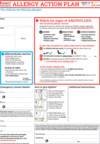
what are the risk factors for developing peanut or tree nut allergy?
- Eczema (Transcutaneous sensitization)
- Filaggrin mutations
- Eczema Creams containing Peanut oil (arachis)
- Egg allergy
- Asthma (78% of fatal anaphylaxis)
- Teenagers and young adults (risk taking, alcohol, Adrenaline Auto Injector)
“My child is allergic to fruit and vegetables”… but only some of the time
what is oral antigen syndrome?
Oral allergy syndrome is caused by allergy antibodies mistaking certain proteins in fresh fruits, nuts or vegetables for pollen
- Cross reactivity of tree/plant pollens and foods
- Causes mainly oral symptoms - itching, mouth swelling, tongue discomfort etc…
how do you managed Oral Allergy Syndrome?
- Peeling or cooking often reduces symptoms
- Antihistamine
- Avoidance
- Highly unlikely to cause anaphylaxis
Key is do they have a history of hayfever coexisting with it?
what si the epidemiology of egg allergy?
- Estimated 2% Prevalence in children and 0.1% in Adults
- Most common presentation to allergy clinic in infancy
- 67% grow out of it by 5 Years of age
- Usually mild and benign but can be severe
- Tolerate well cooked egg first and raw egg last
how do you managed egg allergy?
avoidance
re-introduction
egg ladder
Can re-introduce egg as cooking denatures the proteins
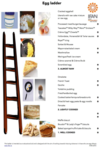
whata re the features of milk allergy?
- Common food allergy in Infancy
- Prognosis: IgE Cows Milk Allergy (50% by 1 year, 70% by 2 years and 85% by 3 years of age)
- Often causes confusion
what are the features of IgE Mediated Cow’s Milk Allergy?
- Rapid onset
- Histamine based reactions
- Symptoms may include vomiting and occasionally diarrhoea
- Can be identified by SPT or SpIgE
what are the features of Non ige Mediated Cow’s milk allergy?
- Not histamine based
- Varying presentations - Diarrhoea, vomiting, irritability, infantile eczema, bloating, bleeding PR
- No diagnostic test other than dietary management
- Improves with withdrawal of milk protein
how do you investigate cows milk allergy?
- History
- Skin Prick Testing
- Specific IgE
- Therapeutic trial of exclusion under dietetic review (After withdrawal, re introduce it after 6 weeks)
what are the different milk formulas that can be used?
Different kind of milk formulas
EHF = extensively hydrolysed formula
AA = amino acid formulas, less allergen prone
Once child reaches a year of age try get them on one of the bottom ones (protein based milks)
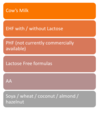
Therapeutic Milk Formulas - what milk formulars can be used for IgE mediated, non-IgE mediated and lactose

Managed of IgE and non-IgE CMA is pretty similar
what is Management of IgE:CMA
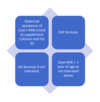
what is the prognosis of cows milk protein allergy?
- Most children better by age 3 (IgE Mediated)
- Early introduction of CMP
- Milk Ladder


